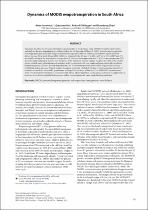JavaScript is disabled for your browser. Some features of this site may not work without it.
- ResearchSpace
- →
- Research Publications/Outputs
- →
- Journal Articles
- →
- View Item
| dc.contributor.author |
Jovanovic, Nebojsa

|
|
| dc.contributor.author |
Mu, Q

|
|
| dc.contributor.author |
Bugan, Richard DH

|
|
| dc.contributor.author |
Zhao, M

|
|
| dc.date.accessioned | 2015-10-30T09:44:27Z | |
| dc.date.available | 2015-10-30T09:44:27Z | |
| dc.date.issued | 2015-01 | |
| dc.identifier.citation | Jovanovic, N., Mu, Q., Bugan, R.D.H and Zhao, M. 2015. Dynamics of MODIS evapotranspiration in South Africa. Water SA, Vol 41(1), pp 79-90 | en_US |
| dc.identifier.issn | 0378-4738 | |
| dc.identifier.uri | http://www.ajol.info/index.php/wsa/article/view/112109 | |
| dc.identifier.uri | http://hdl.handle.net/10204/8211 | |
| dc.description | Copyright: 2015. South African Water Research Commission | en_US |
| dc.description.abstract | This paper describes the dynamics of evapotranspiration (ET) in South Africa using MOD16 ET satellite-derived data, and analyses the inter-dependency of variables used in the ET algorithm of Mu et al. (2011). Annual evapotranspiration is strongly dependent on rainfall and potential evapotranspiration (PET) in 4 climatically different regions of South Africa. Average ET in South Africa (2000–2012) was estimated to be 303 mm·a-1 or 481.4 x 109 m3·a1 (14% of PET and 67% of rainfall), mainly in the form of plant transpiration (T, 53%) and soil evaporation (Soil E, 39%). Evapotranspiration (ET) showed a slight tendency to decrease over the period 2000–2012 in all climatic regions, except in the south of the country (winter rainfall areas), although annual variations in ET resulted in the 13-year trends not being statistically significant. Evapotranspiration (ET) was spatially dependent on PET, T and vapour pressure deficit (VPD), in particular in winter rainfall and arid to semi-arid climatic regions. Assuming an average rainfall of 450 mm·a-1, and considering current best estimates of runoff (9% of rainfall), groundwater recharge (5%) and water withdrawal (2%), MOD16 ET estimates were about 15% short of the water balance closure in South Africa. The ET algorithm can be refined and tested for applications in restricted areas that are spatially heterogeneous and by accounting for soil water supply limiting conditions. | en_US |
| dc.language.iso | en | en_US |
| dc.publisher | South African Water Research Commission | en_US |
| dc.relation.ispartofseries | Workflow;14430 | |
| dc.subject | MOD16 ET satellite-derived data | en_US |
| dc.subject | Potential evapotranspiration | en_US |
| dc.subject | Soil evaporation | en_US |
| dc.subject | Transpiration | en_US |
| dc.subject | Water balance | en_US |
| dc.title | Dynamics of MODIS evapotranspiration in South Africa | en_US |
| dc.type | Article | en_US |
| dc.identifier.apacitation | Jovanovic, N., Mu, Q., Bugan, R. D., & Zhao, M. (2015). Dynamics of MODIS evapotranspiration in South Africa. http://hdl.handle.net/10204/8211 | en_ZA |
| dc.identifier.chicagocitation | Jovanovic, Nebojsa, Q Mu, Richard DH Bugan, and M Zhao "Dynamics of MODIS evapotranspiration in South Africa." (2015) http://hdl.handle.net/10204/8211 | en_ZA |
| dc.identifier.vancouvercitation | Jovanovic N, Mu Q, Bugan RD, Zhao M. Dynamics of MODIS evapotranspiration in South Africa. 2015; http://hdl.handle.net/10204/8211. | en_ZA |
| dc.identifier.ris | TY - Article AU - Jovanovic, Nebojsa AU - Mu, Q AU - Bugan, Richard DH AU - Zhao, M AB - This paper describes the dynamics of evapotranspiration (ET) in South Africa using MOD16 ET satellite-derived data, and analyses the inter-dependency of variables used in the ET algorithm of Mu et al. (2011). Annual evapotranspiration is strongly dependent on rainfall and potential evapotranspiration (PET) in 4 climatically different regions of South Africa. Average ET in South Africa (2000–2012) was estimated to be 303 mm·a-1 or 481.4 x 109 m3·a1 (14% of PET and 67% of rainfall), mainly in the form of plant transpiration (T, 53%) and soil evaporation (Soil E, 39%). Evapotranspiration (ET) showed a slight tendency to decrease over the period 2000–2012 in all climatic regions, except in the south of the country (winter rainfall areas), although annual variations in ET resulted in the 13-year trends not being statistically significant. Evapotranspiration (ET) was spatially dependent on PET, T and vapour pressure deficit (VPD), in particular in winter rainfall and arid to semi-arid climatic regions. Assuming an average rainfall of 450 mm·a-1, and considering current best estimates of runoff (9% of rainfall), groundwater recharge (5%) and water withdrawal (2%), MOD16 ET estimates were about 15% short of the water balance closure in South Africa. The ET algorithm can be refined and tested for applications in restricted areas that are spatially heterogeneous and by accounting for soil water supply limiting conditions. DA - 2015-01 DB - ResearchSpace DP - CSIR KW - MOD16 ET satellite-derived data KW - Potential evapotranspiration KW - Soil evaporation KW - Transpiration KW - Water balance LK - https://researchspace.csir.co.za PY - 2015 SM - 0378-4738 T1 - Dynamics of MODIS evapotranspiration in South Africa TI - Dynamics of MODIS evapotranspiration in South Africa UR - http://hdl.handle.net/10204/8211 ER - | en_ZA |






